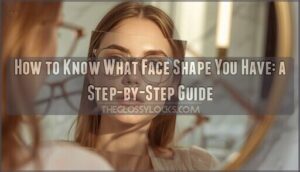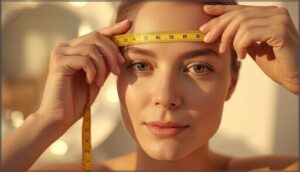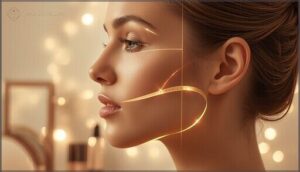This site is supported by our readers. We may earn a commission, at no cost to you, if you purchase through links.
You stand in front of the mirror with a new pair of glasses perched on your nose. They looked perfect on the model. On you, they look completely wrong. The problem isn’t the glasses. It’s that you picked a style meant for a different face shape.
Most people guess their face shape based on a quick glance, but those guesses are often off by a full category. The difference between a round face and an oval face might seem obvious until you start taking actual measurements. Your cheekbones, jawline, and forehead width tell a specific story about your proportions.
Once you know how to measure these features correctly, you can choose hairstyles, frames, and accessories that actually work with your natural structure instead of fighting against it.
Table Of Contents
- Key Takeaways
- How to Know What Face Shape You Have
- Step-by-Step Face Shape Measurement Guide
- Using AI Tools to Detect Face Shape
- Identifying The Six Most Common Face Shapes
- Tips for Accurate Face Shape Analysis
- Frequently Asked Questions (FAQs)
- What is the best way to determine my face shape?
- What are some common face shapes?
- Is there any other information I should consider when determining my face shape?
- What face shape is best?
- Do round faces age better?
- Can face shape change with age or weight?
- Do hairstyles affect how face shape looks?
- What if my face matches multiple shapes?
- Are certain face shapes more common genetically?
- How does gender influence typical face shape?
- Conclusion
Key Takeaways
- You can figure out your face shape by measuring four key areas: forehead width, cheekbone width, jawline width, and face length from hairline to chin.
- Most faces fall into six main categories—oval, round, square, rectangle, heart, and diamond—with oval being the most common at about 77% of people.
- AI face shape tools can analyze your features in seconds with 82-94% accuracy, but you’ll get better results with good lighting, hair pulled back, and a neutral expression.
- Knowing your true face shape helps you pick glasses, hairstyles, and accessories that work with your natural structure instead of against it.
How to Know What Face Shape You Have
Knowing your face shape isn’t just about vanity. It actually helps you choose hairstyles, glasses, and makeup that bring out your best features.
Before you start measuring, let’s cover why face shape matters, which facial features to observe, and the main categories you’ll encounter.
Why Face Shape Matters
Understanding your face shape isn’t just about appearance—it shapes how others see you and how you see yourself. Research shows facial features influence attractiveness perceptions and trigger social stereotypes within seconds.
Your face shape influences how others perceive you and shapes your own self-image within seconds of meeting
Your face shape also has cosmetic significance when choosing eyewear or hairstyles, carries psychological impact on confidence, and stems from genetic factors passed through families.
Face shape analysis reveals measurable insights about your unique facial structure; for example, high cheekbones are often considered a feature of beauty.
Key Facial Features to Observe
Your face shape is revealed through specific facial proportions and bone structure. To determine yours accurately, focus on these key facial features:
- Forehead width – measured across the hairline at its widest point
- Cheekbone width – spanning from one side to the other
- Jawline width – measured at its broadest below the ears
- Face length – from hairline to chin
- Overall harmony – how these facial feature measurements relate to each other
Understanding these aspects helps with face shape identification.
Common Face Shape Categories
Once you know which features to measure, you’ll see that faces generally fall into six main face shape categories. Research shows oval face is most common—about 77% of people have this shape. Round face, square face, heart, diamond, and rectangle make up the rest. Some faces show hybrid shapes that blend two categories.
Cultural perceptions and shape misidentification often occur when people skip careful measurement.
Step-by-Step Face Shape Measurement Guide
The best way to figure out your face shape is to take some simple measurements at home. You’ll need a flexible tape measure and a mirror to get started.
Below are the exact steps to measure each part of your face and compare the numbers to find your shape.
Measuring Forehead Width
Your forehead is the widest part between your temples, about halfway from your eyebrows to your hairline. Use a soft tape measure and keep it level for accurate face shape analysis.
The typical forehead measures around 12 centimeters across. Record this value in centimeters so you can compare it with your cheekbone and jaw measurements later. This helps with shape categorization.
Measuring Cheekbone Width
Cheekbones sit just below the outer corners of your eyes. Place your tape measure from one side to the other, keeping it straight across the bridge of your nose. This measurement often becomes the widest part of your face.
The typical adult cheekbone width falls between 12 and 13 centimeters. Write this number down for your face shape analysis.
Measuring Jawline Width
Your jaw creates the lower frame of your face. Find the point just below your ear where the jawline curves. Place your tape measure from that spot down to the middle of your chin. Double this number to get your full jawline width. Most adults measure between 10 and 12 centimeters.
This dimension helps separate square faces from diamond shapes during face shape analysis.
Measuring Face Length
The tallest measurement runs from your hairline reference point down to the lowest point of your chin position. This face length number usually falls between 17 and 23 centimeters in adults.
Dividing your face into vertical thirds helps reveal proportional deviations. Calculate your facial index by dividing face length by face width, then multiply by 100.
These face measurements guide accurate face shape classification through facial proportion analysis and facial feature measurement.
Comparing Proportions for Accurate Results
Once you have your face measurements, calculating your facial index reveals your true shape. Divide face length by face width and multiply by 100.
This key ratios method drives AI comparison tools with up to 99.6% measurement accuracy. Compare your numbers against standard facial features analysis benchmarks, keeping in mind population variance affects facial proportion analysis.
Your face shape emerges from these face measurements working together.
Using AI Tools to Detect Face Shape
If measuring your face manually feels too tricky, AI tools can do the work for you in seconds. These online detectors use smart technology to analyze your features and give you instant results.
Here’s what you need to know to get accurate readings and keep your photos safe.
How Online Face Shape Detection Works
Here’s the thing: modern online face shape detectors work like highly trained experts studying your facial proportions instantly. Artificial intelligence algorithms map 68 key features across your face—measuring your forehead, cheekbones, and jawline—then compare these measurements to patterns learned from thousands of images. The result? AI accuracy rates hit 82-94%, often beating human experts. Machine learning models process everything in seconds.
- Feature detection precisely identifies distances between facial features
- Model training uses diverse datasets for reliable classification
- Algorithms deliver instant results with confidence scores
Preparing Your Photo for Best Results
Think of your photo as the AI’s first impression—it needs to see your face clearly to work its magic. Pull your hair back and position yourself front-facing to the camera.
Good lighting conditions matter more than you’d think; soft, even light without harsh shadows helps the algorithm read your features accurately. Use a plain background with contrast behind you.
Keep your facial expression neutral. Upload a recent, sharp image with no filters or occlusions blocking your face.
Privacy and Data Security Considerations
Before you upload, know what happens to your image. Most face-shape tools don’t clearly say how long they keep your photos or what they do with them. Check their privacy policy for data retention details. Look for platforms that delete images immediately after analysis.
Be aware that facial data can’t be changed if breached, unlike passwords. Choose services with transparent consent standards and strong security practices to protect your biometric information.
Identifying The Six Most Common Face Shapes
Now that you know how to measure your face, let’s see which shape fits yours best.
There are six main face shapes that most people fall into. Below, you’ll find what makes each one unique and how to spot your own.
Oval Face Shape Characteristics
Your oval face shape features ideal proportions where length exceeds width by about 1.5 times. The cheekbones form your widest point, while your forehead and jawline remain balanced and similar in width.
You’ll notice soft contours throughout—a gently rounded hairline, moderately pronounced cheekbones, and a smooth jawline without sharp angles.
This balanced arrangement of facial features creates the versatility many find attractive.
Round Face Shape Characteristics
Your round face shape has nearly equal length and width, creating a balanced, circular appearance. The cheekbones form your widest point, and your forehead, cheekbones, and jawline are all similar in width. You’ll notice soft contours throughout—smooth curves instead of sharp angles.
This facial index generally falls between 80 and 85. Round faces are often perceived as approachable and youthful, appearing frequently across diverse populations worldwide.
Square Face Shape Characteristics
Your square face shape features equal proportions across three key areas: forehead, cheekbones, and jawline. The jawline prominence creates defining angles and straight lines rather than soft curves.
What distinguishes your square face:
- Strong, angular jawline with visible corners
- Forehead width matching cheekbone and jaw width
- Minimal facial tapering from top to bottom
Square faces are often perceived as assertive and determined. This shape appears more frequently among certain populations, reflecting genetic and demographic patterns in facial structure variation.
Rectangle Face Shape Characteristics
Your rectangle face combines length with structure. The forehead, cheekbones, and jawline maintain similar widths, creating straight sides rather than curves. You’ll notice a strong jawline with defined angles and a longer face length compared to width.
The angular shapes and even width distribution give rectangles their distinctive tall, defined appearance. This face shape shares qualities with both ovals and squares while standing apart through its balanced width distribution across all facial proportions.
Heart Face Shape Characteristics
If your forehead and cheekbones dominate while your chin tapers gracefully, you likely have a heart-shaped face. This distinctive bone structure creates an inverted triangle silhouette. Determining face shape becomes easier when you spot these heart face shape characteristics:
- Forehead width measures roughly 1.5 times your chin width
- High cheekbone height positioned at 55–60% from chin upward
- Smooth jawline taper narrowing to a delicate chin point
Many notice a widows peak hairline completing the look, though it’s not universal. These facial proportions give heart faces their balanced, feminine appearance.
Diamond Face Shape Characteristics
When your cheekbones steal the spotlight, you might’ve a diamond face. This rare shape features zygomatic prominence—wide cheekbones paired with a narrow forehead and jaw. Face shape analysis reveals sharp facial angles and a distinct jawline taper toward a pointed chin.
Misclassification risks are high since automated tools often confuse diamonds with heart shapes, but styling implications matter: side-swept layers balance those striking facial features beautifully.
Tips for Accurate Face Shape Analysis
Getting your face shape right doesn’t have to be complicated, but a few simple tricks can save you from common pitfalls.
Whether you’re measuring at home or using technology, knowing what works best will give you confidence in your results.
Here’s how to make sure your analysis is as accurate as possible.
Using Selfies and Tracing Techniques
You can boost face shape analysis accuracy by taking a straight-on selfie and tracing your jawline and facial features over it. Mobile apps with feature point placement tools achieve over 90% reproducibility—meaning you’ll get consistent results.
More than three-quarters of people under 30 already use selfies for face analysis, and the user experience is fast and clear when lighting is neutral.
Avoiding Common Measurement Mistakes
Even tiny errors in feature placement or lighting conditions can throw off your face shape analysis. Here’s how to avoid the most common pitfalls:
- Pull hair completely away from your face and keep your head position straight—tilting introduces angular errors beyond 5°.
- Use neutral, even lighting to prevent shadows from distorting facial proportions by up to 1.5 mm.
- Place measurement points consistently each time—deviations create repeatability issues in facial measurement methods.
- Avoid relying on visual guessing alone—observer bias leads to classification errors in roughly 28% of cases.
When to Use Professional or AI Analysis
Professional analysis suits clinical or cosmetic procedures where precision impacts outcomes—roughly 38% of cases involve surgical planning.
For beauty and styling, an online face shape detection tool using artificial intelligence delivers instant results at lower cost. AI face shape detectors analyzing facial features reach over 90% accuracy under proper conditions, while traditional methods often miss the mark.
Choose based on your personalization needs and speed requirements.
Frequently Asked Questions (FAQs)
What is the best way to determine my face shape?
Think of your face like a blueprint—you need the right tools to read it. Measuring forehead, cheekbones, jawline, and face length gives you the clearest picture, but AI face shape detectors work faster and help confirm what you’ve measured.
What are some common face shapes?
Six face shapes are most common: oval, round, square, rectangle, heart, and diamond. Each shape has distinct proportions in forehead width, cheekbone prominence, jawline angles, and overall face length.
Is there any other information I should consider when determining my face shape?
Age considerations, weight fluctuations, and genetic factors all affect your facial structure over time.
Lighting impacts how you see face angles, while hairstyle effects can hide or highlight facial features and facial symmetry.
What face shape is best?
No single face shape is objectively best. Research shows symmetry matters more than contour, and cultural ideals vary widely.
Averageness preference, proportional harmony, and dimorphism influence attractiveness—not your specific outline.
Do round faces age better?
Round face shapes often show delayed wrinkle formation and stronger fat preservation in cheeks. This helps maintain youthfulness perception longer, though volume loss and sagging patterns eventually appear with significant facial aging changes.
Can face shape change with age or weight?
Yes, your face shape can shift with aging facial changes and weight loss effects. Bone structure impact, soft tissue shifts, and hormonal influence alter facial features over time, changing how your face appearance looks from your younger years.
Do hairstyles affect how face shape looks?
Your hair can be a major factor—literally framing your face differently.
Hairstyles affect how face shape looks by shifting visual lines, altering perceived proportions, and emphasizing or softening features like your jawline and forehead width.
What if my face matches multiple shapes?
Many faces show measurement ambiguity, blending features from multiple face types. This shape overlap reflects normal population diversity.
Instead of forcing one label, use practical implications from each matching category for hairstyles and styling choices.
Are certain face shapes more common genetically?
Think of face shapes like fingerprints—they cluster in patterns, but genetics shuffles the deck differently across populations.
Research shows oval and round face types dominate globally, though ethnic variations create distinct proportions and feature distributions.
How does gender influence typical face shape?
Gender influences face shape through measurable differences: male faces are usually longer with squarer jawlines, while female faces tend to be rounder with softer contours.
These gender-specific variations reflect distinct facial proportions and feature sizes.
Conclusion
Your face is like a puzzle that’s already solved—you just need to read the picture on the box. Once you know how to measure forehead width, cheekbones, jawline, and face length, you won’t second-guess your shape again.
The right glasses, hairstyle, and accessories will finally make sense. Learning how to know what face shape you have takes ten minutes. Using that knowledge well can change how confident you feel every day.
- https://pmc.ncbi.nlm.nih.gov/articles/PMC8997325/
- https://www.scielo.org.mx/scielo.php?script=sci_arttext&pid=S1405-55462020000200733
- https://www.thieme-connect.com/products/ejournals/pdf/10.1055/s-0043-1770765.pdf
- https://www.nature.com/articles/s41598-021-91579-4
- https://bjfalm.com/ojs/index.php/bjfalm/issue/download/3/23












